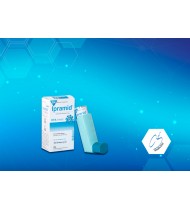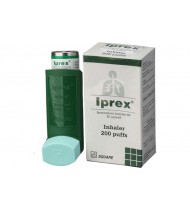Ipratropium Bromide (Inhaler)
Indications
Ipratropium inhaler is indicated for-
- As bronchodilator in treatment of chronic reversible airway obstruction as in asthma and Chronic Obstructive Pulmonary Disease (COPD) including chronic bronchitis and emphysema.
- Treatment of acute reversible airways obstruction.
Pharmacology
Ipratropium bromide causes bronchodilation by blocking the action of acetylcholine at parasympathetic site in bronchial smooth muscle. It also inhibits serous and seromucous gland secretions by nasal application.
Dosage
Adults: The usual dose is 1-2 puffs (20 µg/puff) three or four times daily. Single-dose up to 80 µg (4 puffs) may be required to obtain maximum benefit during early treatment. Patients may take additional inhalations as required: however, the total number of inhalations should not exceed 12 puffs in 24 hours.
Children:
No specific information on the use of the product in the elderly is available. Clinical trials have included patients over 65 years and no adverse reactions specific to this age group have been reported.
Children:
- 6-12 years: Usually 1-2 puffs two to three times daily.
- Bellow 6 years: The usual dose is 1 puff (20 µg) three times daily.
No specific information on the use of the product in the elderly is available. Clinical trials have included patients over 65 years and no adverse reactions specific to this age group have been reported.
Administration
Using an Inhaler seems simple, but most patients do not know how to use it in the right way. If the Inhaler is used in the wrong way, less medicine can reach the lungs. Correct and regular use of the Inhaler will prevent or lessen the severity of asthma attacks.
Following simple steps can help to use Inhaler effectively (According to "National Asthma Guidelines for Medical Practitioners" published by Asthma Association):
Following simple steps can help to use Inhaler effectively (According to "National Asthma Guidelines for Medical Practitioners" published by Asthma Association):
- Take off the cap.
- Shake the inhaler (at least six times) vigorously before each use.
- If the inhaler is new or if it has not been used for a week or more, shake it well and release one puff into the air to make sure that it works.
- Breathe out as full as comfortably possible & hold the inhaler upright.
- Place the actuator into mouth between the teeth and close lips around the mouthpiece.
- While breathing deeply and slowly through the mouth, press down firmly add fully on the canister to release medicine.
- Remove the inhaler from mouth. Continue holding breath for at least for 10 seconds or as long as it is comfortable.
- If doctor has prescribed more than one inhalation per treatment, wait 1 minute between puffs (inhalations). Shake the inhaler well and repeat steps 4 to 7.
- After use, replace the cap on the mouthpiece. After each treatment, rinse mouth with water.
- Check your technique in front of a mirror from time to time, if you see a white mist during the inhalation, you may not have closed your lips properly around mouthpiece, or you may not be breathing in as you press the can. This indicates failure of technique. If this happens, repeat the procedure from step 4 carefully.
Interaction
Ipratropium bromide has been used concomitantly with other drugs, including sympathomimetic bronchodilators, methylxanthines, steroids and cromolyn sodium, commonly used in treatment of COPD, without any adverse drug reactions, there are no studies fully evaluating the interaction effects of lpratropium bromide and these drugs in respect to effectiveness.
Contraindications
Known hypersensitivity to ipratropium bromide, Atropine or its derivative. Also contraindicated in patients with a history of hypersensitivity to soya lecithin or related food products such as soyabean, lecithin and peanut.
Side Effects
Idiosyncratic reactions to lpratropium bromide are rare. Severe adverse effects due to inhibition of muscarinic receptors and ganglion blockade are theoretically possible but unlikely with the metered-dose aerosol. Regular use of ipratropium can lead to a dry mouth through inhibition of salivary flow.
Other most common adverse reactions reported are - dryness of the oropharynx (5%); cough, exacerbation of symptoms, & imitation from aerosol (3%); headache (2%); nausea, dizziness, blurred vision/difficulty in accommodation & drying of secretions (1%).
Less frequently reported adverse reactions include tachycardia, nervousness, paresthesias, drowsiness, co-ordination difficulty, itching, flushing, alopecia, constipation, tremor & mucosal ulceration. Case of precipitation or worsening of narrow-angle glaucoma, acute eye pain & hypotension also have been reported. Allergic-type reactions such as skin rash, angio-oedema of tongue, lips & face, urticaria (including giant urticaria), laryngospasm and anaphylactic reaction have been also reported; with positive rechallenge in some cases.
Ipratropium bromide dose not produce adverse effects on mucociliary clearance, in contrast to atropine and other muscarinic antagonists. There is no evidence that in the therapeutic does range ipratropium bromide has any adverse effect on bronchial secretion.
Other most common adverse reactions reported are - dryness of the oropharynx (5%); cough, exacerbation of symptoms, & imitation from aerosol (3%); headache (2%); nausea, dizziness, blurred vision/difficulty in accommodation & drying of secretions (1%).
Less frequently reported adverse reactions include tachycardia, nervousness, paresthesias, drowsiness, co-ordination difficulty, itching, flushing, alopecia, constipation, tremor & mucosal ulceration. Case of precipitation or worsening of narrow-angle glaucoma, acute eye pain & hypotension also have been reported. Allergic-type reactions such as skin rash, angio-oedema of tongue, lips & face, urticaria (including giant urticaria), laryngospasm and anaphylactic reaction have been also reported; with positive rechallenge in some cases.
Ipratropium bromide dose not produce adverse effects on mucociliary clearance, in contrast to atropine and other muscarinic antagonists. There is no evidence that in the therapeutic does range ipratropium bromide has any adverse effect on bronchial secretion.
Pregnancy & Lactation
The safety of Ipratropium Bromide during human pregnancy has not been established. The benefits of using Ipratropium Bromide during a confirmed or suspected pregnancy must be weighed against possible hazards to the unborn child. It is not known whether Ipratropium Bromide is excreted into breast milk.
Precautions & Warnings
Patients should be advised that temporary blurring of vision, precipitation or worsening of narrow angle glaucoma or eye pain may result if the aerosol is sprayed into the eyes. If recommended dosage does not provide relief or symptoms become worse, patients should seek immediate medical attention. While taking ipratropium bromide inhalation aerosol, other inhaled drugs should not be used unless prescribed.
lpratropium bromide inhalation aerosol is not indicated for the initial treatment of acute episodes of bronchospasm where rapid response is required. Drugs with faster onset may be preferable as initial therapy in this situation. Immediate hypersensitivity reactions may occur after administration of ipratropium bromide, as demonstrated by rare cases of urticaria, angio-oedema, rash, bronchospasm and oropharyngeal oedema.
lpratropium bromide inhalation aerosol is not indicated for the initial treatment of acute episodes of bronchospasm where rapid response is required. Drugs with faster onset may be preferable as initial therapy in this situation. Immediate hypersensitivity reactions may occur after administration of ipratropium bromide, as demonstrated by rare cases of urticaria, angio-oedema, rash, bronchospasm and oropharyngeal oedema.
Overdose Effects
Acute overdosage by inhalation is unlikely since ipratropium bromide is not well absorbed systematically after administration as aerosol. Inhaled dosage of 5 mg of ipratropium bromide produce an increase in heart rate and palpitation. Single doses of ipratropium bromide 30 mg by mouth caused anticholinergic side effects but which were not considered severe enough to require specific reversal.
Therapeutic Class
Anticholinergic bronchodilators
Storage Conditions
The inhaler should be stored in a dry and cool place. Protected from direct sunlight and heat. Keep away from eyes. Keep out of reach of children. The canister should not be broken, punctured or burnt, even when apparently empty.
Ipramid Inhaler 200 metered doses
IndicationsIpratropium inhaler is indicated for-As bronchodilator in treatment of chronic reversible..
220.00Tk.
Iprex Inhaler 200 metered doses
IndicationsIpratropium inhaler is indicated for-As bronchodilator in treatment of chronic reversible..
250.75Tk.
Showing 1 to 2 of 2 (1 Pages)


